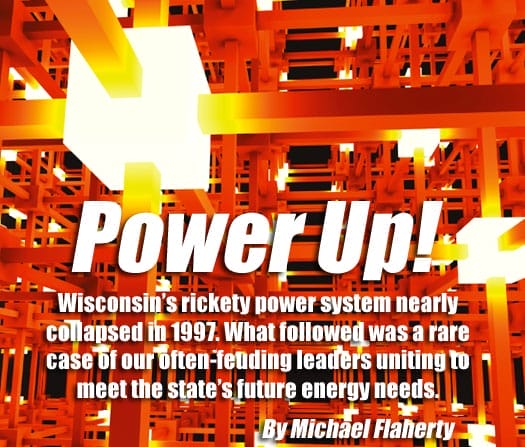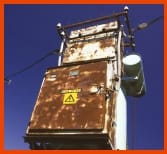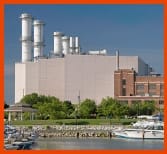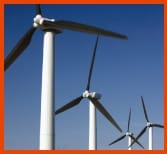In the summer of 1997, Wisconsin’s electrical generation system was in trouble. Two of the state’s nuclear generating plants were down for repairs, and as the summer started getting hotter, Wisconsin and its economy came close to blackout — a regional or possibly even a statewide crash of its electrical generation system.
“We were very close to a major disruption that would have caused serious damage to the state’s economy,” says Steve Kraus, spokesman for Madison Gas & Electric, a utility that serves the Madison area. Customers were calling Kraus with sharp questions for which he had no good answers. They were legitimate questions, too, he adds. Manufacturing customers require huge amounts of electricity, while businesses and the state’s then-emerging technology industries require power that flows at precise voltages and amperages. So even “brownouts” (not failures, losses of voltage) could have had serious consequences.
It’s impossible to calculate the economic catastrophe that might have been created in 1997 by a statewide brownout, rolling blackout or total blackout. But it’s not hard to envision it in broad strokes. Wisconsin’s economic output that year was about $160 billion, or about $440 million a day. Even a regional disruption could have cost hundreds of millions of dollars.
As India demonstrated this past summer, the failure of an electrical grid can spread quickly. India’s circuits kept popping until the blackout spread 2,000 miles, putting nearly 10 percent of the world’s population in the dark.
The reason for Wisconsin’s 1997 blackout scare wasn’t complicated. For more than a decade, Wisconsin’s utilities had not built a major electrical generating plant or done a major transmission system upgrade, while demand for electricity was projected to grow more than 2 percent per year — the equivalent of a new 500-megawatt electric generating plant every two years.
With no major power plants being built, or even planned, Wisconsin was facing a situation in which the state’s economy would soon demand more electricity than its utilities could deliver. We Energies, which serves the heavily industrialized southeast, was projecting that Wisconsin would be 4,000 megawatts short of its electrical needs by 2010. And that projection didn’t include the planned retirements of the state’s oldest coal-burning power plants, a third of which were more than 50 years old.
The utility industry and the state’s political and business leaders knew they were operating on borrowed time.
“We faced very serious reliability problems,” says Ave Bie, chairwoman of the Wisconsin Public Service Commission from 1998 to 2004. “We knew we needed new generation — and we needed the investor-owned utilities to start building.”
Fast forward to the summer of 2012. High temperatures around the state set records, and Wisconsin experienced more than a month’s worth of highs over 90 degrees and nearly a dozen days with highs over 100.
At the same time, Wisconsin’s economic output had grown nearly two-thirds (to $254 billion in 2011), and Wisconsin manufacturers were coming back to life from the 2008 recession, re-energizing their production lines and their need for electricity to power them.
Yet this summer, Wisconsin’s electricity production system didn’t miss an electron. Even at the height of summer demand, Wisconsin was actually exporting electricity — with an estimated 22 percent of its megawatts of generating capacity still in reserve.
“We signed up for interruptible power in exchange for lower electric rates,” explains John Torinus, chief executive of Serigraph, a specialized printing company in West Bend that buys about $1.25 million worth of electricity per year. “In the last six years, we’ve never had our power interrupted — not even once,” even though the agreement allows the utility to shut off power to his plant if systemwide demand starts outstripping the utility’s capacity.)
In fact, Wisconsin utility representatives, regulators and observers such as Bie say the state is now well-positioned for years into the future as the nation’s electrical generation system — and the way we use electricity — faces enormous changes and challenges.
“It is very hard to site new transmission lines or build a new coal generation facility, but we got it done,” says Bie, who is now managing partner at Quarles and Brady law firm in Madison specializing in regulatory law and utility legal issues. “And today, it is clear we made a good decision.”
What happened in Wisconsin starting in 1997 is a case of good government, good leadership and good public policy.
In 1997, Wisconsin’s political and business leaders, as well as consumer representatives, all agreed the state’s outmoded electrical generation and transmission system was a serious threat to future economic growth. They knew that failing to act could cost millions in terms of lost productivity and jobs — and could cost billions in lost future state growth and investment, especially in energy-dependent sectors such as manufacturing.
And they fixed it.
Over several years, they worked together, laid out enormously ambitious plans, and took substantial political risks to build the legislative, regulatory, business and consumer support needed to reinvest in and modernize Wisconsin’s generation and transmission system.
At the table in legislative discussions in 1997, 2001 and again in 2005 were utility leaders; consumer groups such as the Citizens Utility Board, Customers First! and the Wisconsin Industrial Energy Group; business groups including Wisconsin Manufacturers & Commerce and the Milwaukee Area Chamber of Commerce; and legislative leaders from both political parties. During this time, state government was in the hands of governors from both parties, Tommy Thompson, Scott McCallum and Jim Doyle.
Since then — after not building a new power plant in more than a decade — Wisconsin has opened 36 new and rebuilt power plants. This includes facilities powered by coal, natural gas and renewable energy sources, with the capacity to generate an additional 7,313 megawatts of electricity — more than half again as much as the state’s total capacity in the mid-1990s.
Those leaders came together again in 2001 to support a second piece of legislation that created a new system to rebuild Wisconsin’s electric transmission system and that connected the state with a regional electricity marketing organization. And in 2005, they cooperated again (albeit with much less unanimity) to support legislation to help Wisconsin join the national drive for electricity produced from renewable energy sources such as wind.
The problems facing Wisconsin’s electrical grid in 1997 were as complicated as the grid itself. The technical problems weren’t easily understood. Reserve margins, prices and projected demand increases varied by utility and by region of the state. One small utility in the 1990s even enjoyed summer reserves as high as 25 percent.
Wisconsin was linked with other states by three interstate power lines that, while limited, could import electricity when Wisconsin plants couldn’t keep up. And the industry had tools such as energy efficiency efforts, customer-demand management tools, time-of-day pricing and interruptible demand.
But major areas of population such as southeastern Wisconsin still faced a crisis in 1997 in which electrical supply was at times within 1 percent of customer demand. That meant, in essence, there was no reserve margin — let alone the 15 percent-plus required by regulators.
Wisconsin utilities didn’t even own enough generating capacity to serve their customers during periods of peak demand. They were instead meeting that razor-thin margin between supply and demand through load-balancing tools and by importing up to 1,000 megawatts of electricity from other states.
“It was a very serious situation,” says MGE’s Kraus.
Adds Bie: “Even the University of Wisconsin was deeply concerned because its research facilities use a lot of electricity — and they needed that reliability.”
More worrisome, the economy and demand for electricity were projected to grow by 2 percent or more per year — with higher growth in parts of the state that had some of the lowest reserve margins. Manufacturing, about a fourth of the state’s economic output in1997, was the state’s most power-thirsty sector and projected to grow 2.7 percent per year.
In short, the Public Service Commission’s first Strategic Energy Assessment concluded in 2000: Major regions of Wisconsin faced “serious reliability problems.”
One important step had already been taken. In May 1998, the Legislature passed — and Gov. Tommy Thompson signed — the Electric Reliability Act (Act 204), a comprehensive piece of legislation designed to streamline the process for planning and approving new power plants and transmission lines. The law replaced the Advanced Plan process which, in the PSC’s words, was designed to “efficiently” take into consideration all the major factors that go into planning new power facilities, such as demand, reliability, prices, environmental impact and economic impacts.
But it was a complicated process that included steep regulatory hoops and involved a large number of groups with deep divisions over how to proceed with Wisconsin’s energy future. Supporters of the Advanced Plan process argued forcefully that approving major projects such as new power plants should be slow, with great attention to detail. Utility leaders argued that it was a recipe for regulatory gridlock, which, given what was happening at the time, was hard to dispute.
Once the Reliability Act passed, utilities got right to work. Wisconsin Energy Corp. (We Energies) launched “Power the Future,” a $6 billion plan to build 1,200 megawatts of new electric generation in the form of two large coal-fired plants as well as a huge natural-gas-fired power plant. It later re-launched the project as a $7 billion proposal that included the conversion of an older, less efficient coal plant to natural gas as well as a host of environmental and transmission system upgrades. By itself, Power the Future would add 2,800 megawatts of electric generating capacity to Wisconsin’s energy grid.
Green Bay-based Wisconsin Public Service Corp. soon followed with its plan to build a 500-megawatt coal-burning plant at its Weston facility, near Wausau.
Act 204 also paved the way for another new, important player in Wisconsin’s electric generation industry: independent “merchant” power producers. The act partially deregulated the industry for non-utilities by removing the rule requiring proof of “need” for a new power plant, a major sticking point in debates over new power plant approval under the Advanced Plan process.
Under 204, plants could be built as long as their builders could show they didn’t create major environmental problems. It was up to the owners to bear the risk of whether the market — or the “need” — existed for the electricity. With that enormous regulatory hurdle removed, private companies could now build power plants in Wisconsin.
Lawmakers also flirted with the idea of a fully deregulated Wisconsin electric industry to expand investment in electric generation and transmission. However, California’s disastrous deregulation experiment, which sparked shortages and enormous price increases, quickly short-circuited that idea.
In the end, Act 204 stabilized Wisconsin’s electricity market, freeing up private companies to build “merchant” plants while still requiring state regulatory oversight. The law required the state’s regulated utilities to purchase “merchant” electricity under long-term contracts. It also gave the PSC joint authority to oversee “merchant” plants that are normally regulated only by the Federal Energy Regulatory Commission.
Partial deregulation worked. Since Act 204’s passage, Wisconsin has seen the construction of 25 natural gas-fired power plants, which burn more efficiently, emitting less carbon dioxide, sulfur dioxide and particulate matter than the plants they replaced. Most are investor-owned power plants that have become an important part of Wisconsin’s generating capacity, especially during peak demand.
In 2001, Wisconsin’s business, consumer and political leadership came together again to address the other critical problem facing Wisconsin’s electric generation system: an outmoded electric transmission system.
The legislation helped form the American Transmission Co., the nation’s first private, multistate company to own and manage a state’s electric transmission system. ATC also connected Wisconsin to the Midwest’s newly formed regional electricity sales and marketing organization called MISO (the Midwest Independent Transmission System Operators). MISO would enable Wisconsin to buy and sell power from neighboring states quickly and efficiently — and allow the state to participate in regional planning for future generation and transmission.
Today, ATC, owned by 29 investor-owned utilities, electric cooperatives, municipal utilities and local governments in four states, maintains 9,440 miles of power lines. Since 2001, ATC has invested $2.7 billion in Wisconsin, Michigan, Minnesota and Illinois — and plans to spend another $4 billion in the next decade to upgrade old lines and build new ones.
ATC’s job was to plan, finance, site and build new transmission lines, which by itself is very difficult, says Bie, reflecting back on the enormous public battle over the construction of the Arrowhead-Weston line that would eventually link Wisconsin with Canada’s low-cost, renewable hydroelectric power supplies. “But creating ATC also allowed the utilities to focus on building new power plants, which is also extremely difficult.”
And they all delivered as promised, she notes.
Finally in 2005, the industry and state leaders acted together again — though, admittedly with less consensus. Under Gov. Jim Doyle, the Legislature passed Act 141, which paved the way for a new generation of plants powered by renewable energy sources such as wind. It requires that by 2015, 10 percent of electricity sold by utilities must come from renewable energy sources.
Since then, Wisconsin utilities have built 10 new wind farms with another major wind facility expected to come on line next year.
All that investment in power generation plants and transmission lines has come at a price, of course. Most of that $15 billion investment required loans that ultimately are repaid by utility customers in the form of higher prices for electricity. Wisconsin’s electricity prices, among the lowest in the Midwest in 1997, are the highest. The average price for electricity (for all types of customers) has nearly doubled since 1990, from just over 5 cents a kilowatt-hour to nearly 10 cents, according to the PSC.
As a result Wisconsin’s consumers, notably its businesses and industries that must compete nationally and internationally, are struggling with higher electricity prices as they also wrestle with the worldwide recession and aggressive competition from low-wage countries.
In light of high prices and huge margins of supply, the complaint now is that Wisconsin has “overbuilt” its system — especially as the PSC considers proposals for even more new generation with very high capital costs, which would push electric rates even higher.
But Wisconsin’s energy prices are still below the national average, as the PSC noted this summer in its most recent Strategic Energy Assessment report, which examines the state’s electrical needs through 2018. It also pointed out that Wisconsin’s personal incomes have grown faster than energy prices over the same period, and that after the construction of new power plants and transmission lines, Wisconsin is well-positioned for a rapidly changing future in the world of electric supply and demand.
“The magnitude and mix of new electric generation” means that “Wisconsin’s generation supply future appears in strong shape,” the 2018 SEA concludes. And that supply “will be available at reasonable rates.”
The new construction did cost a lot of money, admits Bie.
“But the most expensive power you can buy is the power you don’t have when you need it. That can cost a larger company a lot of money.”
“I’m not wild about these higher rates,” says Torinus. “But in the end, I have to lean in favor of higher reliability. We own part of a plant in India. The lights are always flickering [there], and, this summer, a lot of our customers faced serious disruptions.”
At the same time, however, environmental questions hang heavily over the electric generating industry. That’s because new Environmental Protection Agency rules that go into full effect in 2015 will hit the Midwest’s coal-burning plants hard.
The nine states that make up the Midwest Independent Transmission System Operators are home to 70,000 megawatts of generating capacity produced by coal-burning power plants. Of that capacity, 60,000 megawatts will be affected by the new EPA rules, and a substantial portion of those plants face more than one EPA hurdle.
Critics argue that coal-burning power plants are responsible for the bulk of the emissions of nitrogen dioxide, sulfur dioxide, mercury and carbon dioxide into the atmosphere. They say that building more coal-fired plants would be a poor alternative to aggressive conservation efforts combined with new investments in alternative sources of energy.
However, lost in Wisconsin’s debate over building new, more efficient coal-burning power plants was the fact that those plants would allow the retirement or retrofitting of 26 old coal-burning power plants, nearly 1,000 megawatts of power. None of those plants were equipped with modern pollution controls, which can eliminate almost all the nitrogen dioxide, sulfur dioxide and particulate matter, and a majority of the mercury.
MISO estimates that the regionwide price tag to meet the new EPA regulations could be as high as $33 billion, including the cost of closing 100 coal-based power plants now generating 12.6 gigawatts in those nine states. That capacity will have to be replaced by either new, more efficient coal-burning plants, nuclear or natural gas-fired plants or renewable energy facilities — all of which will be much more expensive.
Thanks to the decisions Wisconsin started making in 1998, the state may have a leg up. Because state utilities began investing more than a decade ago in new, more efficient power plants, transmission lines and environmental controls on older power plants, Wisconsin utilities now generate substantial amounts of electricity from modern, advanced coal-burning technology with the latest environmental controls. That means Wisconsin utilities will receive top priority when MISO coordinates sales of electricity around the region.
More importantly, when the EPA rules go into effect, other Midwestern states will be required to spend billions to upgrade and replace their power plants, while Wisconsin utilities will already have been there, done that. Wisconsin ratepayers are already as much as 10 years into their payment schedules on those 36 new and upgraded facilities, including coal plants with the latest emission controls, new natural gas plants, and new wind farms.
Finally, those new transmission lines are allowing Wisconsin utilities to export their surplus electricity. That revenue will help pay off the new power plants, to the relief of ratepayers. “Wisconsin is on the front edge of the construction cycle,” deadpans the PSC in its SEA-2018 report. “The newer units in Wisconsin have a benefit over the other plants in the MISO footprint.”
MISO is the real game-changer, utility leaders say.
To maximize efficiencies of production and transmission regionwide, MISO is playing an unexpectedly major role in deciding which power plants to close, where to build new power plants and how to best build and maintain an electric transmission system.
MISO also prices and sells large amounts of electricity between states with surprisingly
little involvement by the utilities selling and buying the power in the nine-state region. The transactions occur within five minutes, which means MISO determines where the lowest-cost electricity is available and pulls the switch on the sale.
MISO’s role in the marketplace is enormous. Last year it bought and sold $27.5 billion worth of electricity to the 374 market participants in its region. That role will only expand as the electric industry faces changes. Wisconsin should be well-situated because it is ahead of the investment curve.
There is still a lot of work to do. The nation’s energy generation and transmission system faces huge challenges in the way America generates, transports and uses electricity.
But because Wisconsin’s business, consumer and political leadership acted early and decisively, those leaders are still seeing that those early decisions were correct and that they are paying off handsomely to make Wisconsin a winner as the nation’s energy future evolves.
SIDEBAR: Change is Coming
Wisconsin’s energy future potentially includes enormous changes that will challenge state leaders:
- New EPA rules to take effect in 2015 that could change the cost and efficiency of and future investment in electrical generation powered by fossil fuels.
Among the unknowns is how the nation will deal with carbon dioxide emissions from power plants. A “tax’’ on such emissions, for example, could dramatically affect the cost of electricity produced from coal and natural gas.
- A smarter electricity transmission and distribution grid system that could distribute power more precisely and quickly to customers — with less energy loss.
Technologies also are being developed to improve electric generation produced in smaller quantities closer to the point of consumption. These technologies could have a major impact on how — and where — we locate new power plants and associated facilities.
- A broader market-sharing agreement that could expand MISO (the Midwest Independent Transmission System Operators) into the southern states, bringing Wisconsin into a network with more buyers and sellers of electricity.
That means more markets for Wisconsin’s surplus electricity — and more sellers with which Wisconsin utilities must compete.
- A potentially broad reallocation of generating capacity as the utilities in the MISO region decide — separately and as a group — how to comply with the new EPA rules.
This could include the closing of 100 coal-fired power plants, huge investments in retrofitting existing coal plants with costly modern emission controls, the construction of new transmission lines or the construction of new plants.
- New energy efficiency technologies for consumers, businesses and manufacturers.
In the past two decades, manufacturers have become dramatically more efficient in the way they use electricity. For consumers, huge savings have been achieved, for example, with new lighting systems.
- New, cost-efficient forms of renewable energy generation, such as new wind and solar power technologies
- Uncertain energy prices.
Natural gas prices were highly volatile a decade ago — and now coal prices are volatile. Fossil fuel prices (and projections of costs and supplies) are a key factor in determining the competitive value of producing electricity from nuclear plants and renewable sources of energy.
- Changes in energy consumption patterns.
If electric cars become popular, demand for electricity could put substantial strains on the nation’s electric grid, requiring new pricing systems or rules to encourage charging cars at night when lower demand for electricity makes greater capacity available.
-M.F.
Michael Flaherty is a former Wisconsin State Journal state government reporter who covered the passage and implementation of energy legislation in 1997 and 2001. He is now president of Flaherty & Associates, a public policy strategic communications and public relations firm. He has worked with utilities, consumer groups and environmental groups on energy issues ranging from stray voltage to pipeline siting.









